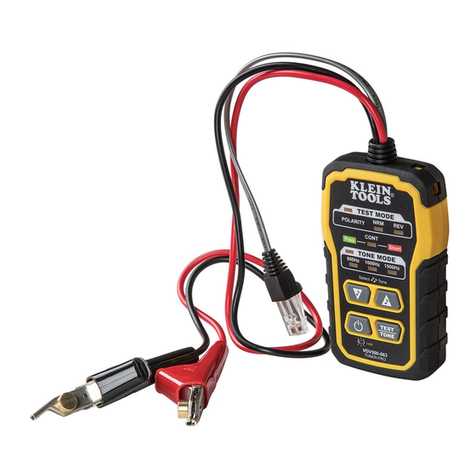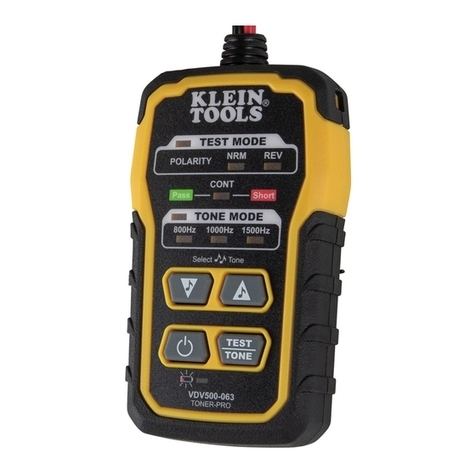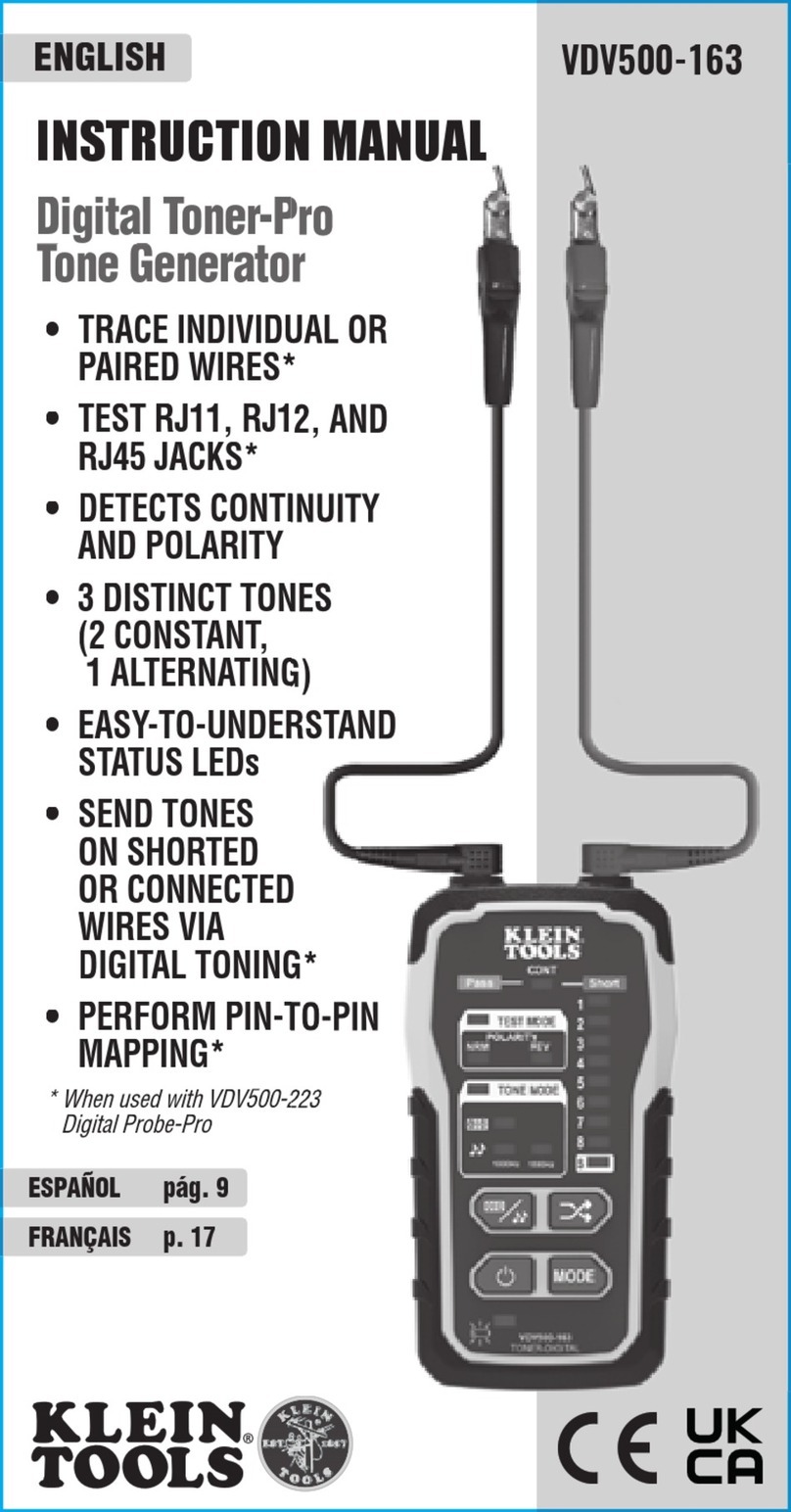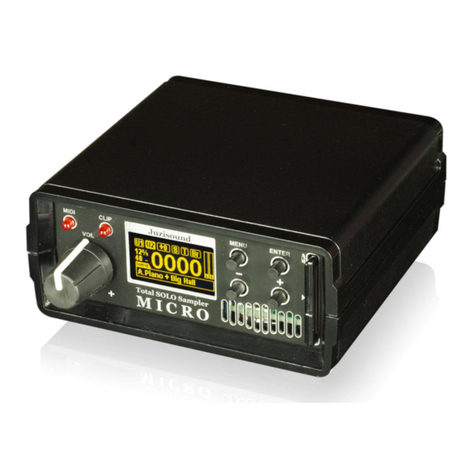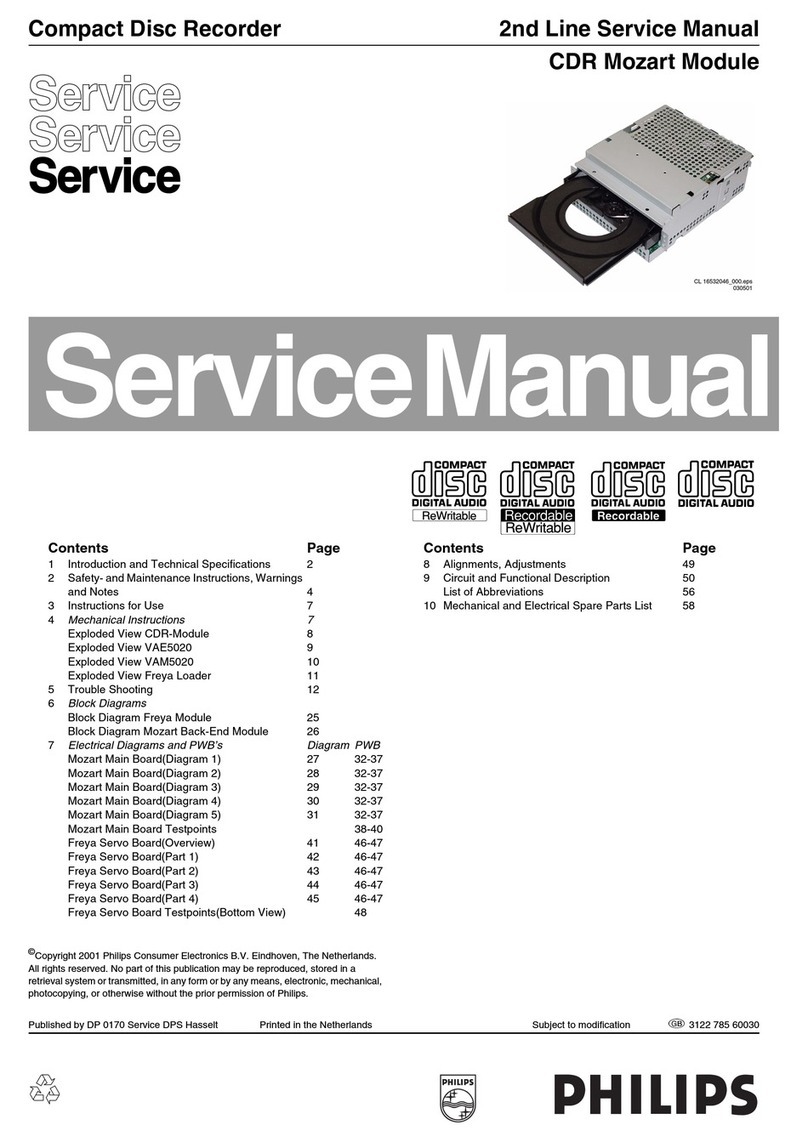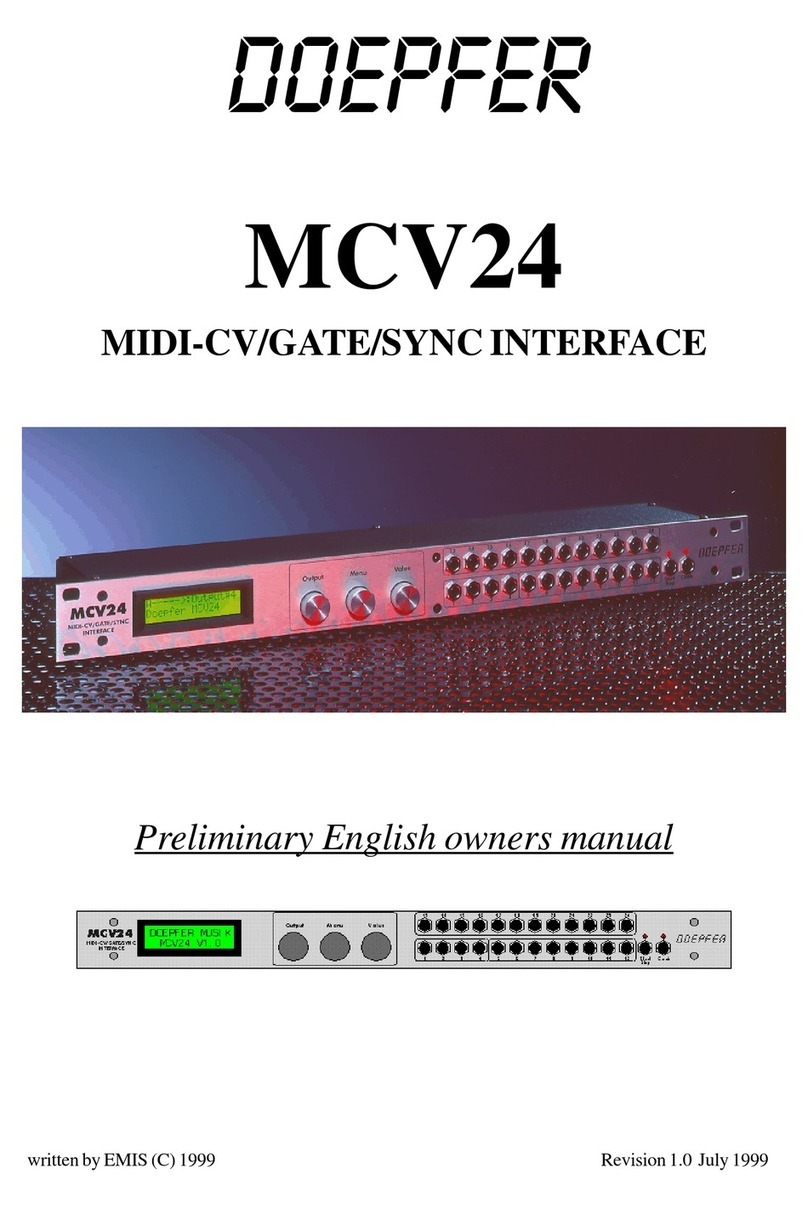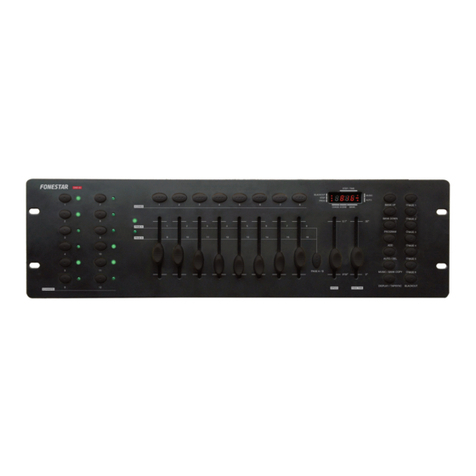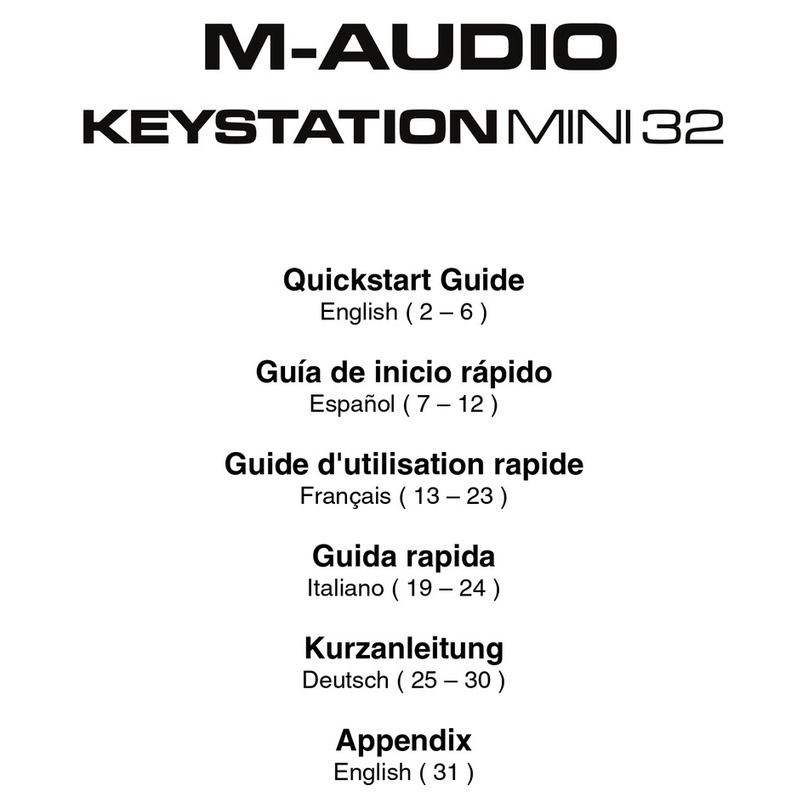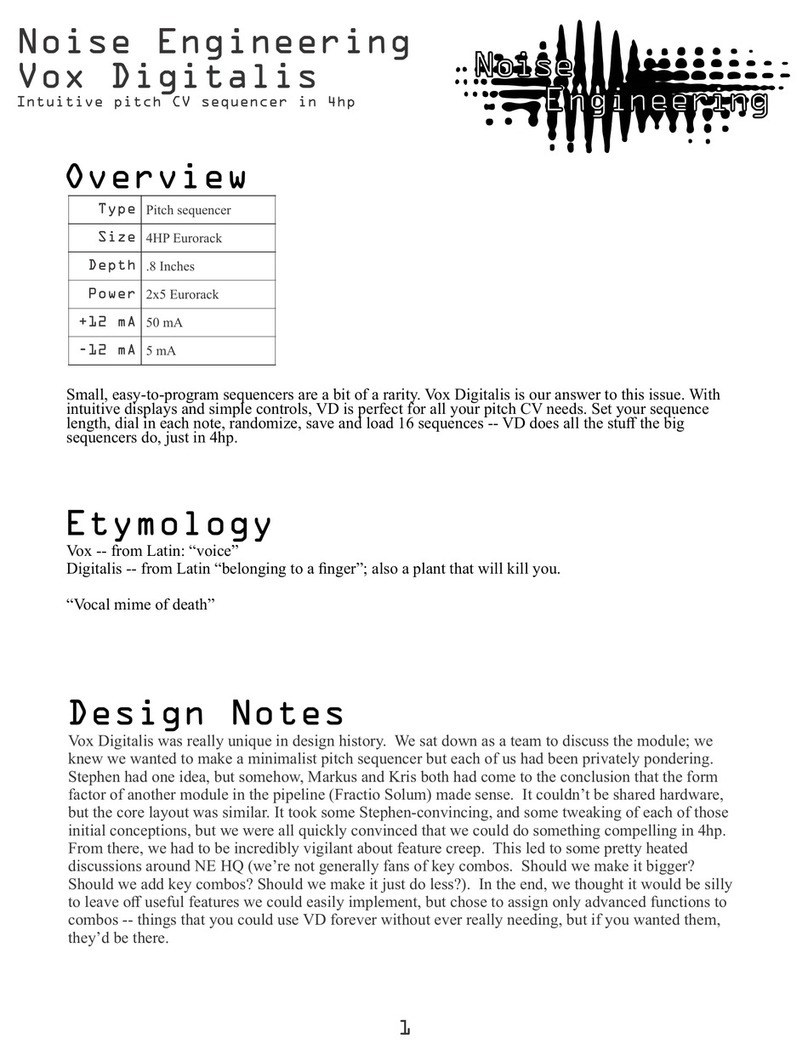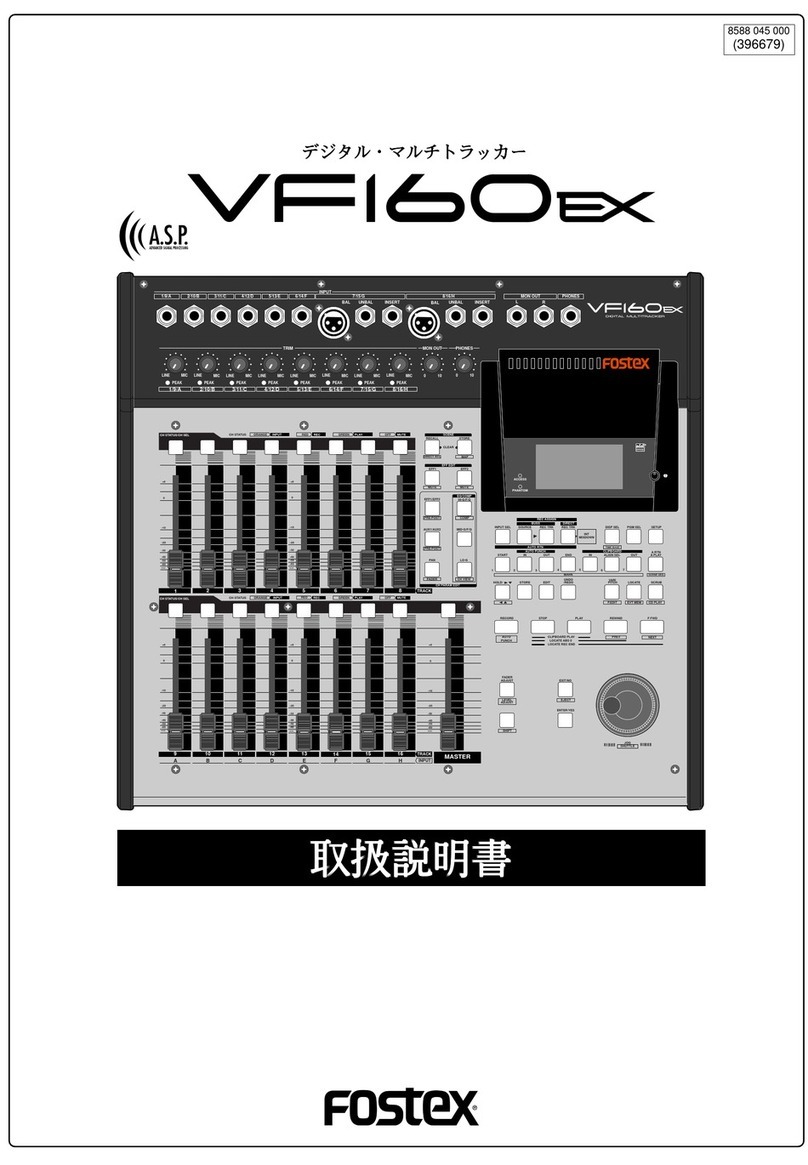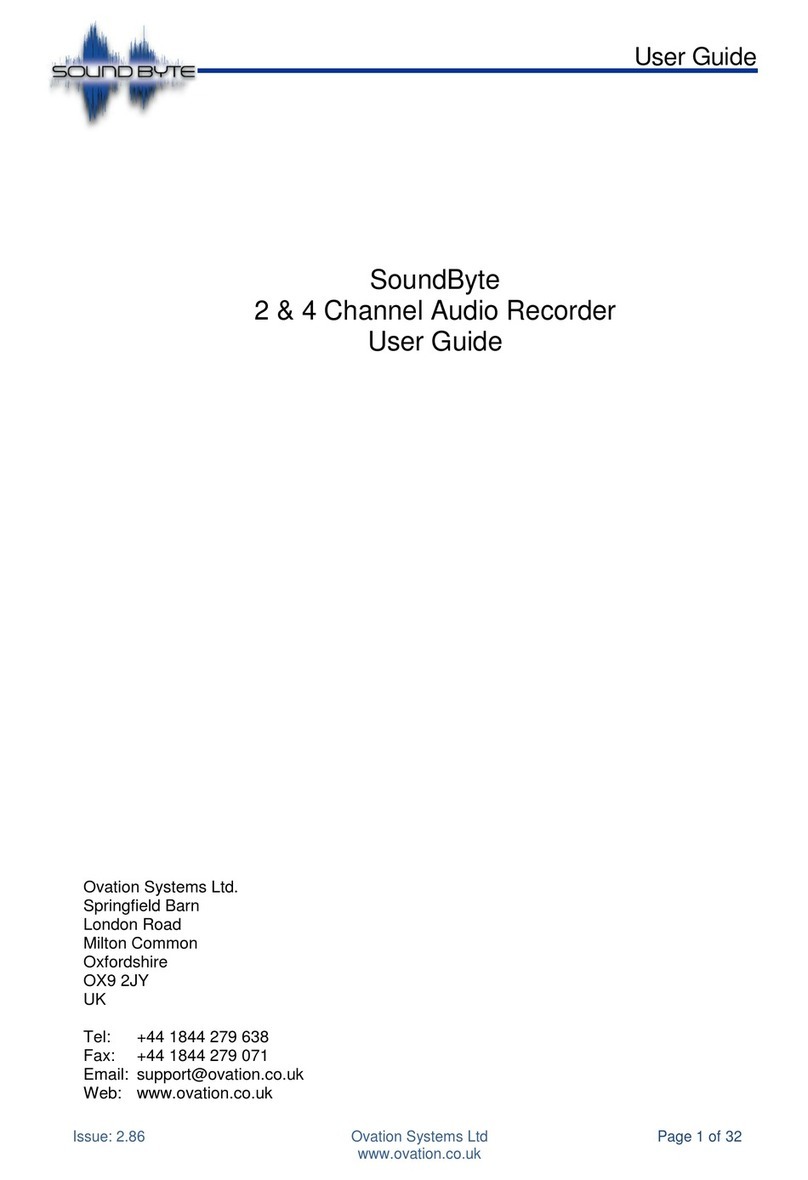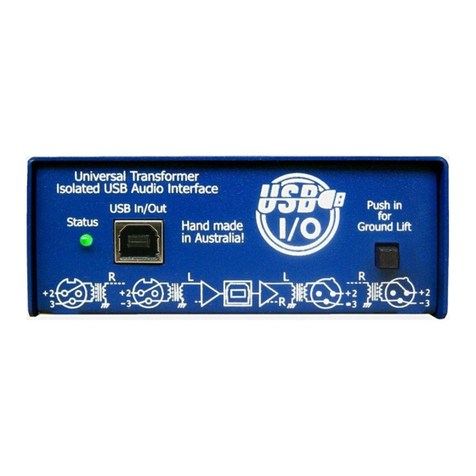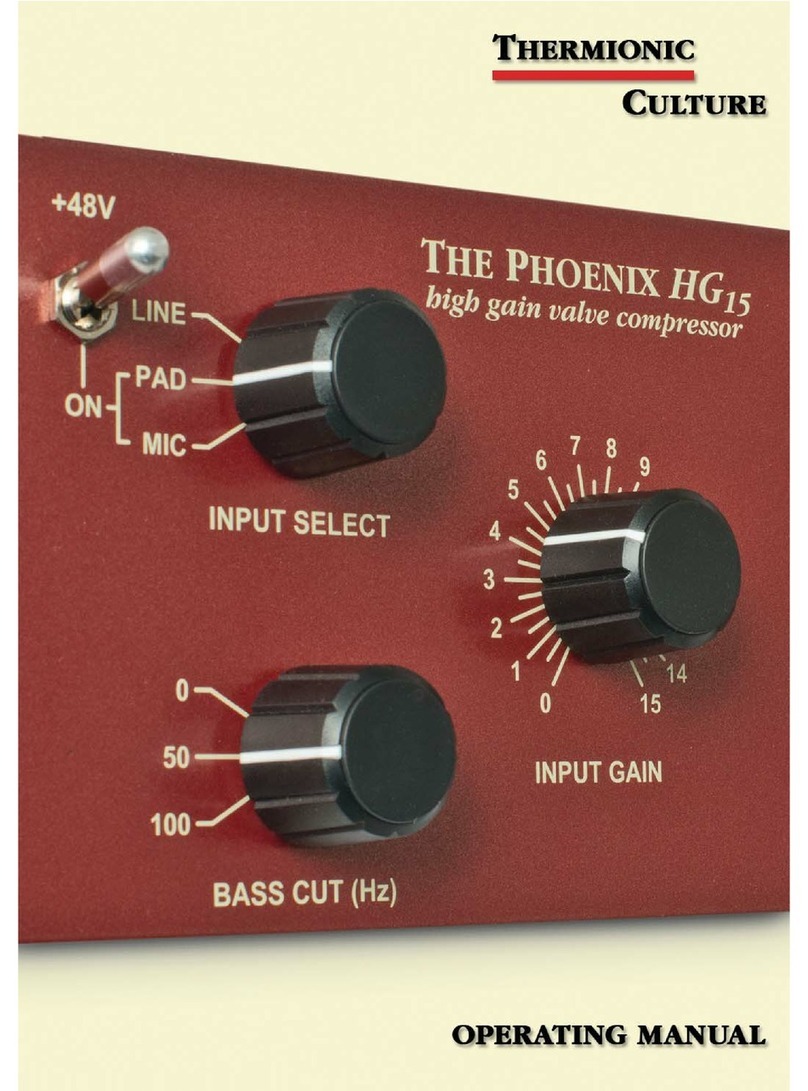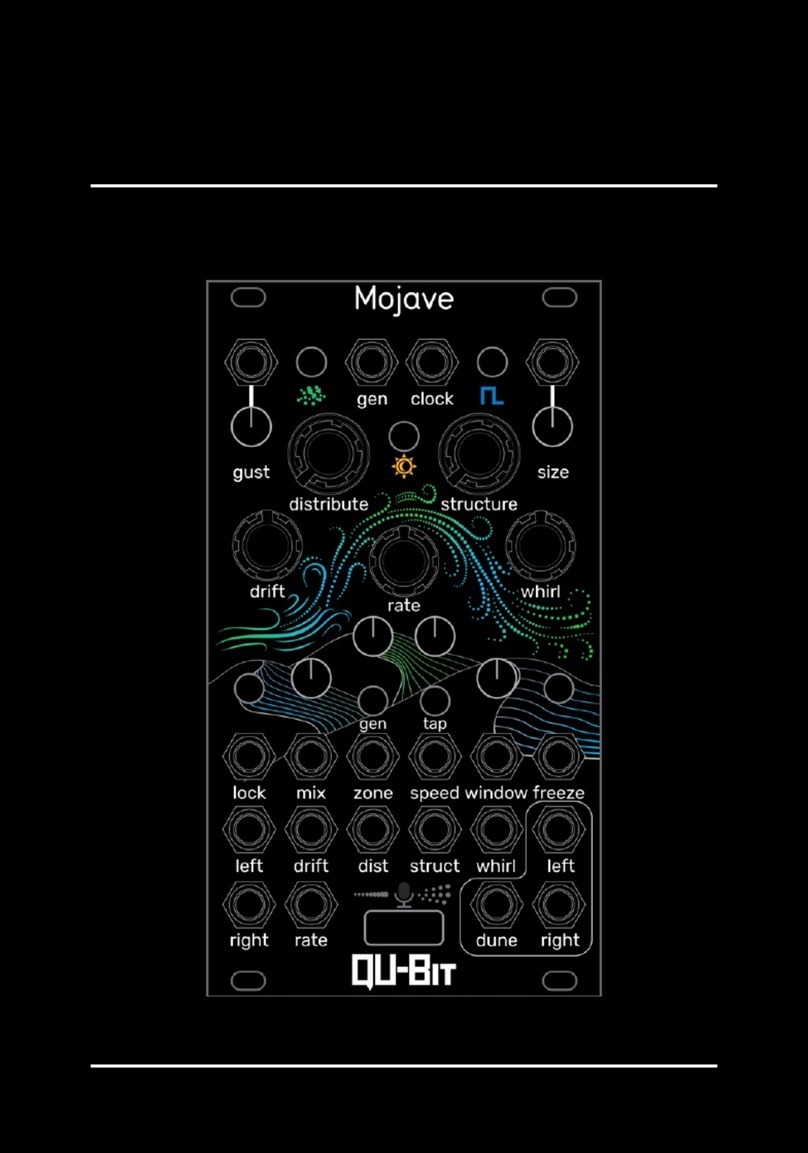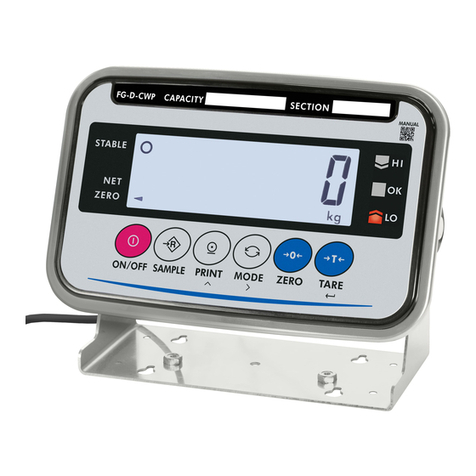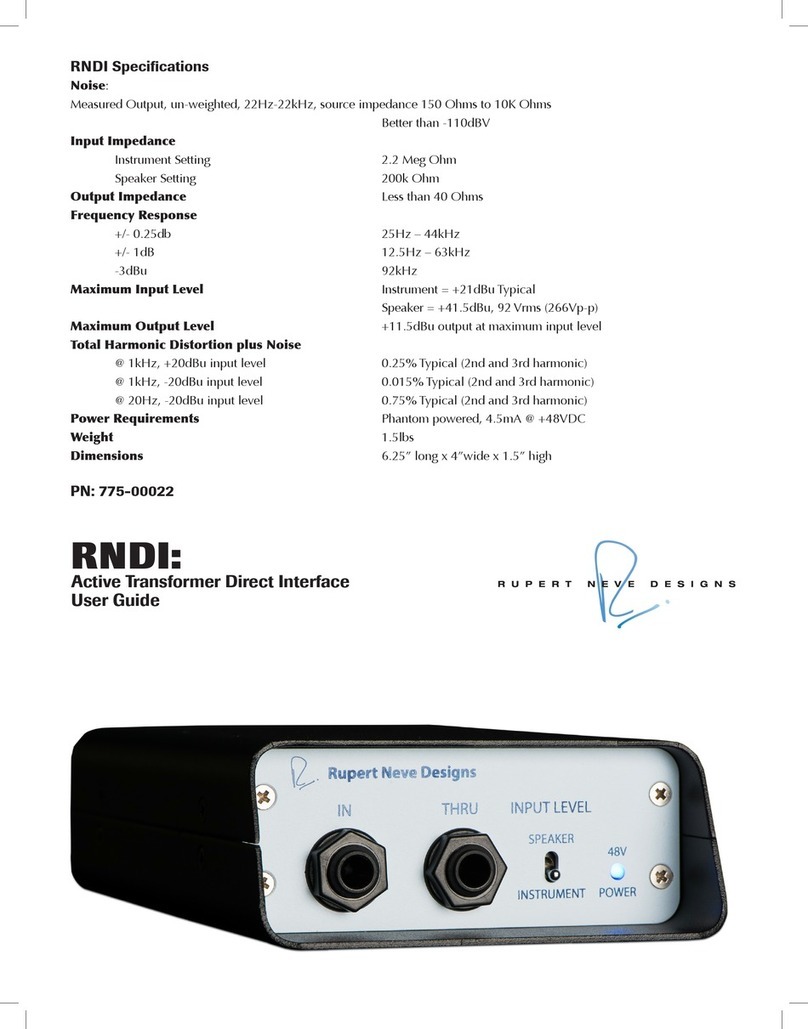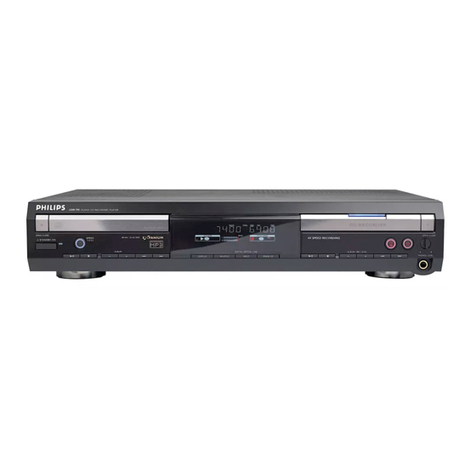Klein Tools Toner-Pro User manual

1
INSTRUCTIONMANUAL
ENGLISH
VDV500-063
Toner-Pro
Tone Generator
FRANÇAIS p. 17
ESPAÑOL pág. 9
• TRACE INDIVIDUAL
OR PAIRED WIRES*
• TEST RJ11, RJ12,
AND RJ45 JACKS*
• DETECTS
CONTINUITY AND
POLARITY
• 5 DISTINCT TONES
(3 CONSTANT,
2 ALTERNATING)
• EASY-TO-
UNDERSTAND
STATUS LEDs
* When used with VDV500-123 Probe-Pro

2
ENGLISH
GENERAL SPECIFICATIONS
The Klein Tools VDV500-063 Toner-Pro is a professional-series tone
generator for wire identification, wire tracing and wire pair identification.
It features several tone frequencies and strong power output for tracing
wires.
• Operating Altitude: 6562 ft. (2000 m) maximum
• Relative Humidity: 10% – 90% non-condensing
• Operating Temp: 14° to 122°F (-10° to 50°C)
• Storage Temp: -4° to 140°F (-20° to 60°C)
• Dimensions: 2.5" x 5" x 1" (64 x 127 x 25 mm)
• Weight: 7.4 oz. (210 g) including batteries
• Battery Type: 4 x 1.5V AAA Alkaline
• Battery Life: Active: 120 hours
Standby/Storage: 3 years
• Auto-Power Off: After 60 minutes of inactivity
• Tones: Constant: 800Hz, 1000Hz, 1500Hz
Alternating: 800Hz/1000Hz, 1000Hz/1500Hz
• Tone Power: 8dBm
• Continuity Indication: Less than 10kΩ
• Voltage Protection: Test Mode: 60V
Tone Mode:
20V through external 600Ω
Specifications subject to change.
T16
T12
T15
FEATURE DETAILS

3
T1
TEST MODE Indicator
T2
"NRM" (Normal)
Polarity Indicator
T3
"REV" (Reverse)
Polarity Indicator
T4
"CONT" (Continuity)
Indicator
T5
TONE MODE
Indicator
T6
Tone Frequency
Indicators
T7
Tone Mode Down
selector button
T8
Tone Mode Up
selector button
T9
Power On/Off Button
T10
TEST/TONE Button
T11
Battery Status
Indicator
T12
Lanyard Slot
T13
RJ11 Test Plug
T14
ABN (Angled Bed-
of-Nails) Test Clips
T15
Battery Cover
T16
Battery Cover Screw
(#2 Phillips)
T1
T5
T7
T9
T8
T10
T13
T14
T11
T2 T3
T4
T6
FEATURE DETAILS

4
ENGLISH
WARNINGS
To ensure safe operations and service of the instruments, follow these
instructions. Failure to observe these warnings can result in re,
electric shock, severe injury or death.
• The Toner-Pro and Probe-Pro (sold seperately) are designed for use on extra-low
voltage cabling systems (less than 60 volts) for testing when NOT energized.
• The maximum voltage across ABN Test Clips of the Toner-Pro is 60 volts in
Test mode, and 20 volts in Continuity mode. Connecting the Probe-Pro to live
mains AC power may damage it and pose a safety hazard for the user.
• DO NOT use instruments if they are wet, as it could pose a shock hazard.
• DO NOT use instruments if they are damaged in any way.
• Turn off instruments and disconnect all ABN Test Clips before attempting to
replace batteries.
• The battery door must be in place and secure before you operate the instrument.
• DO NOT open the case, other than the battery compartment.
OPERATING INSTRUCTIONS
READ ALL INSTRUCTIONS BEFORE OPERATING AND RETAIN
INSTRUCTIONS FOR FUTURE REFERENCE
CONTINUITY TEST
The Toner-Pro transmits frequencies on non-energized wires only. When the
Toner-Pro is turned on, a continuity test will be performed to determine if the 2
wires to be traced are in close proximity to each other, without a conductive path
between them. The "CONT" Indicator
T4
wIll illuminate green to indicate pass.
Attach the red and black ABN Test Clips
T14
to the wires to be tested. If the
resistance of the circuit is less than 10kΩ, the "CONT" Indicator
T4
will illuminate
red and no toning can occur. If the "CONT" Indicator is illuminated green, a tone
can be generated and you may proceed.
SELECTING TONE FREQUENCY
The Toner-Pro defaults to the 800Hz frequency setting when powered on. Use
the Tone Mode Up
T8
and Tone Mode Down
T7
selector buttons to change the
frequency. The Tone Frequency Indicators
T6
will display the frequency being
transmitted. If an alternating tone is selected, the two respective Tone Frequency
Indicators
T6
will blink. Tones will cycle through the available frequencies in a
continuous loop when a selector button is pressed repeatedly.
TRACING PAIRED WIRES (FIG. 1)
1. Connect the Toner-Pro’s red ABN Test Clip
T14
to one of the wires of the
pair to be traced. Connect the black ABN Test Clip
T14
to the other wire to
be traced.
2. Turn Toner-Pro on by pressing the Power On/Off button
T9
.
3. Check the “CONT” Indicator
T4
. If illuminated green, you may proceed.
4. Select the preferred tone setting using the Tone Mode Up
T8
and/or Tone
Mode Down
T7
selector buttons.
5. Turn on the Probe-Pro (sold seperately).
6. At the far end of the cable, spread the wires apart at least 2" (51 mm), if possible.
7. Use the Probe-Pro (sold seperately) to scan the cable’s wire pairs. Move the
Probe-Pro's tip slowly across the wires. The Probe-Pro’s volume will increase
as it approaches the toned pair. When the Probe-Pro’s volume is high over
the first wire, low in the middle (between) the two wires, and high over the
second wire, you have located the pair of wires you are tracing. Use the
Volume Increase and Volume Decrease buttons to adjust the volume.

5
OPERATING INSTRUCTIONS
TRACING NON-PAIRED WIRES (FIG. 2)
1. Connect the Toner-Pro’s red ABN Test Clip
T14
to the wire to be traced.
2. Connect the black ABN Test Clip
T14
to another wire in the cable, but preferably
not in the same pair (connect to ground, if available). When tracing a shielded
cable, connect the red ABN Test Clip to the outer shield, and the black ABN Test
Clip to the center conductor or ground.
3. Turn Toner-Pro on by pressing the Power On/Off button
T9
.
4. Check the “CONT” Indicator
T4
. If illuminated green, you may proceed.
5. Turn on the Probe-Pro (sold seperately).
6. Select the preferred tone setting using the Tone Mode Up
T8
or Tone Mode
Down
T7
selector buttons.
7. At the far end of the cable, spread the wires at least 2" (51 mm) apart, if possible.
8. Use the Probe-Pro (sold seperately) to scan the cable’s wire pairs. Move the
Probe-Pro's tip slowly across the wires. The Probe-Pro’s volume will increase
as it approaches the toned wire.
FIG. 2
2"
(51 mm)
2"
(51 mm)
FIG. 1
VDV500-123
(sold seperately)
VDV500-123
(sold seperately)

6
ENGLISH
OPERATING INSTRUCTIONS
RJ11 / RJ12 / RJ45 TESTING
The Toner-Pro has an RJ11 Test Plug
T13
that can be used in place of the
ABN clips to transmit the tone. The RJ11 plug works with RJ11, RJ12, or
RJ45 jacks. The red and black ABN contacts are replaced by the 2 center
conductors of the inserted plug, i.e. pins 2 and 3 for RJ11, pins 3 and 4 for
RJ12, and pins 4 and 5 for RJ45.
Use the Probe-Pro
(sold seperately)
to locate the toned wires at the far end of
the cable, as described in the TRACING PAIRED WIRES section.
POLARITY AND VOLTAGE PRESENCE TESTING
The Toner-Pro may be used to test the polarity and type of voltage present.
1. Press the
Power On/Off button
T9
on the Toner-Pro.
2. Press the
TEST/TONE Select button
button
T10
. The "TEST MODE" indicator
T1
will illuminate.
3. Connect the
ABN Test Clips
T14
, or insert the
RJ11 Test Plug
T13
.
4. Check the “CONT” Indicator
T4
. If illuminated green, you may proceed.
5. The
"NRM" (Normal) Polarity Indicator
T2
will illuminate if the red
ABN
Test Clip
T14
is connected to the POTS (Plain Ol' Telephone Service) in the
proper orientation. The
"REV" (Reverse) Polarity Indicator
T3
will illuminate
if the wires are reversed.
• The
"NRM" (Normal) Polarity Indicator
T2
will illuminate
when the black
ABN Test Clip detects higher voltage than the red ABN Test Clip.
• The
"REV" (Reverse) Polarity Indicator
T3
w
ill illuminate
when the red
ABN Test Clip detects higher voltage than the black ABN Test Clip.
• The
"NRM" (Normal) Polarity Indicator and "REV" (Reverse) Polarity
Indicator will both illuminate when
AC voltage is present.
• When the
RJ11 Test Plug
is used, the
"NRM" (Normal) Polarity Indicator
will illuminate on
a correctly wired and powered POTS (Plain Ol'
Telephone Service) phone jack.
NOTE: The POTS (Plain Ol' Telephone Service) color code convention
(black/positive, red/negative) is the opposite of the multimeter color
code convention (red/positive, black/negative).

7
CUSTOMER SERVICE
KLEIN TOOLS, INC.
450 Bond Street
Lincolnshire, IL 60069
1-877-775-5346
www.kleintools.com
CLEANING
Be sure equipment is turned off and wipe with a clean, dry lint-free
cloth.
Do not use abrasive cleaners or solvents.
STORAGE
Remove the batteries when equipment is not in use for a prolonged period
of time. Do not expose to high temperatures or humidity. After a period
of storage in extreme conditions exceeding the limits mentioned in the
GENERAL SPECIFICATIONS section, allow the equipment to return to
normal operating conditions before using.
WARRANTY
www.kleintools.com/warranty
DISPOSAL /RECYCLE
Do not place equipment and its accessories in the trash. Items must
be properly disposed of in accordance with local regulations. Please
see www.epa.gov or www.erecycle.org for additional information.
MAINTENANCE
BATTERY REPLACEMENT
When the Low Battery Indicator
T11
blinks, the batteries must be
replaced.
1. Turn off instrument(s) before attempting to replace batteries.
2. Loosen screw
T16
,
on battery cover
T15
.
3. Remove and properly dispose of four 1.5V AAA batteries.
4. Install new batteries (note proper polarity).
5. Replace battery cover and fasten securely with screw.
To avoid risk of electric shock, do not operate while battery door
is removed.

8
ENGLISH
NOTES

9
Generador De
Tono Toner-Pro
• TRAZA ALAMBRES
INDIVIDUALES Y
DE PAR*
• PRUEBA
CONECTORES
RJ11, RJ12 Y
RJ45*
• DETECTA
CONTINUIDAD
YPOLARIDAD
• 5TONOS
DISTINTOS
(3CONSTANTES,
2 ALTERNANTES)
• LED DE ESTADO
FÁCILES DE
ENTENDER
* Cuando se usa con
VDV500-123 Probe-Pro
ESPAÑOL
VDV500-063
MANUALDEINSTRUCCIONES

10
ESPAÑOL
ESPECIFICACIONES GENERALES DEL TONER-PRO VDV500-063
El Toner-Pro VDV500-063 de Klein Tools es un generador de tono de
serie profesional para identificación dealambres, trazado de alambres e
identificación de pares de alambres. Ofrece varias frecuencias de tono
yuna salida de gran potencia para el trazado de alambres.
• Altitud de funcionamiento: 6562pies (2000m) como máximo
• Humedad relativa: 10% a 90%, sin condensación
• Temperatura de funcionamiento: 14° a 122°F (-10° a 50°C)
• Temperatura de almacenamiento: -4° a 140°F (-20° a 60°C)
• Dimensiones: 2,5" × 5" × 1" (64 × 127 × 25mm)
• Peso: 7,4oz (210g) incluida la batería
• Tipo de batería: 4baterías alcalinas AAA de 1,5V
• Vida útil de la batería: En actividad: 120horas
Modo en espera/Almacenamiento: 3años
• Función de apagado automático: después de 60minutos de
inactividad
• Tonos: Constante: 800Hz, 1000Hz, 1500Hz
Alternante: 800Hz/1000Hz, 1000Hz/1500Hz
• Potencia del tono: 8dBm
• Indicador de continuidad: Menos de 10kΩ
• Protección de voltaje: Modo de prueba: 60V
Modo de tono:
20V por medio de 600Ω
externos
Especificaciones sujetas a cambios.
T16
T12
T15
DETALLES DE LAS CARACTERÍSTICAS

11
T1
Indicador TEST MODE
(prueba)
T2
Indicador de polaridad
NRM (normal)
T3
Indicador de
polaridad REV
(inversa)
T4
Indicador CONT
(continuidad)
T5
Indicador TONE
MODE (tono)
T6
Indicadores de
frecuencia de tono
T7
Botón de disminución
del modo Tono
T8
Botón de aumento
del modo Tono
T9
Botón de encendido y
apagado
T10
Botón TEST/TONE
(prueba/tono)
T11
Indicador del estado
de batería
T12
Ranura para cuerda
T13
Conector de prueba
RJ11
T14
Cordones de prueba
ABN (con bornes
deconexión
multicontacto en
ángulo)
T15
Cubierta del
compartimento de
las baterías
T16
Tornillo de la cubierta
del compartimiento
delas baterías (n.º2
Phillips)
T1
T5
T7
T9
T8
T10
T13
T14
T11
T2 T3
T4
T6
DETALLES DE LAS CARACTERÍSTICAS

12
ADVERTENCIAS
Para garantizar el funcionamiento y servicio seguros de los
instrumentos, siga estas instrucciones. Elincumplimiento de estas
advertencias puede provocar un incendio, choque eléctrico, lesiones
gravesola muerte.
• El Toner-Pro y Probe-Pro (se vende por separado) están diseñados
para usarse en sistemas de cableado de voltaje extra bajo (menos de
60voltios) para pruebas cuando estos sistemas NO ESTÁN energizados.
• La tensión máxima entre los cordones de prueba ABN del Toner-Pro
es de 60voltios en el modo de Prueba y de 20voltios en el modo de
continuidad. Conectar el Probe-Pro a una fuente de alimentación de CA
activa puede dañarlo e implicar un riesgo de seguridad para el usuario.
• NO utilice los instrumentos si están húmedos dado que podrían
representar un riesgo de choque eléctrico.
• NO utilice los instrumentos si están dañados.
• Apague los instrumentos y desconecte todos los cordones de prueba ABN
antes de intentar reemplazar las baterías.
• La tapa del compartimiento de las baterías debe estar ajustada en su
lugar antes de operar el instrumento.
• NO abra la carcasa, excepto el compartimiento de las baterías.
INSTRUCCIONES DE FUNCIONAMIENTO
LEA TODAS LAS INSTRUCCIONES ANTES DE UTILIZAR LOS
DISPOSITIVOS Y CONSÉRVELAS PARA CONSULTARLAS EN EL FUTURO.
PRUEBA DE CONTINUIDAD
El Toner-Pro transmite frecuencias sobre alambres no energizados únicamente. Al
encender el Toner-Pro, se realizará una prueba de continuidad para determinar si
los dos alambres que van a trazarse están muy cerca uno del otro, sin un circuito
conductor entre ellos. El indicador CONT (continuidad)
T4
se iluminará de color
verde para dar la indicación de aprobación. Sujete los cordones de prueba ABN
rojo y negro
T14
a los alambres que van a probarse. Si la resistencia del circuito
es inferior a 10kΩ, entonces el indicador CONT (continuidad)
T4
se iluminará de
color rojo y no se producirá ningún tono. Si el indicador CONT (continuidad) se
ilumina de color verde, entonces se producirá un tono y podrá continuar.
SELECCIÓN DE LA FRECUENCIA DE TONO
La frecuencia predeterminada del Toner-Pro cuando está encendido es de 800Hz.
Utilice el botón de aumento del modo Tono
T8
y el botón de disminución del modo
Tono
T7
para cambiar la frecuencia. Los indicadores de frecuencia de tono
T6
mostrarán la frecuencia transmitida. Si se selecciona un tono alternante, los dos
indicadores de frecuencia de tono correspondientes
T6
parpadearán. Los tonos
recorrerán las frecuencias disponibles en un ciclo continuo al presionar un botón de
aumento o disminución de forma repetida.
TRAZADO DE PARES DE ALAMBRES (FIG. 1)
1. Conecte el cordón de prueba ABN rojo del Toner-Pro
T14
a uno de los alambres
del par que va a trazarse. Conecte el cordón de prueba ABN negro
T14
al otro
alambre que va a trazarse.
2. Encienda el Toner-Pro presionando el botón de encendido y apagado
T9
.
3. Revise el indicador CONT (continuidad)
T4
. Si está iluminado de color verde,
entonces puede continuar.
4. Seleccione la configuración de tono preferida utilizando el botón de aumento del
modo Tono
T8
o el botón dedisminución del modo Tono
T7
.
5. Encienda el Probe-Pro (se vende por separado).
6. De ser posible, cree en el extremo del cable una separación de 2" (51mm) entre
los cables.
7. Utilice el Probe-Pro (se vende por separado) para escanear los pares de alambres
del cable. Mueva la punta del Probe-Pro lentamente a lo largo de los alambres.
El volumen del Probe-Pro aumentará a medida que se acerca al par con tono.
Cuando el volumen del Probe-Pro es alto sobre el primer alambre, bajo en medio
de (entre) los dos alambres y alto sobre el segundo alambre, entonces habrá
encontrado el par de alambres que está rastreando. Utilice el botón deaumento
de volumen y el botón de reducción de volumen para ajustar el volumen.
ESPAÑOL

13
TRAZADO DE ALAMBRES SIN PAR (FIG. 2)
1. Conecte el cordón de prueba ABN rojo del Toner-Pro
T14
al alambre que va a
trazarse.
2. Conecte el cordón de prueba ABN negro
T14
al otro alambre del cable, pero
preferiblemente no en el mismo par (conecte a tierra de ser posible). Al trazar
un cable blindado, conecte el cordón de prueba ABN rojo al blindaje exterior y
luego el cordón de prueba ABN negro al conductor central o a tierra.
3. Encienda el Toner-Pro presionando el botón de encendido y apagado
T9
.
4. Revise el indicador CONT (continuidad)
T4
. Si está iluminado de color verde,
entonces puede continuar.
5. Encienda el Probe-Pro (se vende por separado).
6. Seleccione la configuración de tono preferida utilizando el botón de aumento del
modo Tono
T8
o el botón dedisminución del modo Tono
T7
.
7. De ser posible, cree en el extremo del cable una separación de 2" (51mm) entre
los alambres.
8. Utilice el Probe-Pro (se vende por separado) para escanear los pares de
alambres del cable. Mueva la punta del Probe-Pro lentamente a lo largo de
los alambres. El volumen del Probe-Pro aumentará a medida que se acerca al
alambre con tono.
2"
(51 mm)
FIG. 1
FIG. 2
2"
(51 mm)
VDV500-123
(se vende por separado)
INSTRUCCIONES DE FUNCIONAMIENTO
VDV500-123
(se vende por separado)

14
INSTRUCCIONES DE FUNCIONAMIENTO
PRUEBA CON LOS CONECTORES RJ11/RJ12/RJ45
El Toner-Pro tiene un conector de prueba RJ11
T13
que se puede usar
en lugar de los cordones ABN para transmitir el tono. El conector RJ11
funciona con conectores RJ11, RJ12, o RJ45. Los contactos ABN negro
yrojo se reemplazan con los dos conductores centrales del conector
insertado, es decir, las clavijas 2 y 3 para el RJ11, clavijas 3 y 4 para el
RJ12, y clavijas 4 y 5 para el RJ45.
Utilice el Probe-Pro (se vende por separado) para ubicar los alambres con
tono en el extremo del cable como se describe en la sección TRAZADO DE
PARES DE ALAMBRES.
PRUEBA DE POLARIDAD Y PRESENCIA DEL VOLTAJE
El Toner-Pro puede utilizarse para probar la polaridad y tipo de voltaje
presente.
1. Presione el
botón de encendido y apagado
T9
en el Toner-Pro.
2. Presione el
botón de selección TEST/TONE (prueba/tono)
T10
. El indicador
TEST MODE (modo de prueba)
T1
se iluminará.
3. Conecte los
cordones de prueba ABN
T14
o inserte el
conector de prueba
RJ11
T13
.
4. Revise el indicador CONT (continuidad)
T4
. Si está iluminado de color
verde, entonces puede continuar.
5. El
indicador de polaridad NRM (normal)
T2
se iluminará si el
cordón de
prueba ABN
rojo
T14
se conecta al POTS (servicio telefónico ordinario) y
con la orientación adecuada. El
indicador de polaridad REV (inversa)
T3
se
iluminará si se invierten los alambres.
• El
indicador de polaridad NRM (normal)
T2
se iluminará
cuando el
cordón de prueba ABN negro detecte unvoltaje mayor que el del
cordón de prueba ABN rojo.
• El
indicador de polaridad REV (inversa)
T3
se iluminará
cuando
el cordón de prueba ABN rojo detecte unvoltaje mayor que el del
cordón de prueba ABN negro.
• El
indicador de polaridad NRM (normal) y el indicador de polaridad
REV (inversa) se iluminarán cuando
exista voltaje CA.
• Cuando el
conector de prueba RJ11
esté en uso, el
indicador de
polaridad NRM (normal) se iluminará sobre
un conector telefónico
POTS (servicio de telefonía tradicional) correctamente cableado y con
corriente.
NOTA: la convención de códigos de color POTS (negro/positivo,
rojo/negativo) es opuesta a la convención de códigos de color de
multímetros (rojo/positivo, negro/negativo).
ESPAÑOL

15
LIMPIEZA
Asegúrese de que el equipo esté apagado y limpie con un paño
limpio y seco que no deje pelusas.
Noutilice solventes ni
limpiadores abrasivos.
ALMACENAMIENTO
Retire las baterías si no va a utilizar el equipo durante un tiempo
prolongado. No lo exponga a la humedad ni a altas temperaturas.
Luego de un período de almacenamiento en condiciones extremas que
sobrepasen los límites mencionados en la sección ESPECIFICACIONES
GENERALES, deje que el equipo vuelva a las condiciones de
funcionamiento normales antes de utilizarlo.
GARANTÍA
www.kleintools.com/warranty
ELIMINACIÓN/RECICLAJE
No arroje el equipo ni sus accesorios a la basura. Los elementos
se deben desechar correctamente de acuerdo con las regulaciones
locales. Visite www.epa.gov o www.erecycle.org para obtener más
información.
MANTENIMIENTO
REEMPLAZO DE LA BATERÍA
Cuando el indicador de batería baja
T11
se parpadea, se deben reemplazar
las baterías.
1. Apague el/los instrumento/instrumentos antes de intentar reemplazar
las baterías.
2. Afloje el tornillo
T16
,
de la cubierta del compartimiento de las baterías
T15
.
3. Retire y deseche correctamente las cuatro baterías AAA de 1,5V.
4. Instale baterías nuevas (tenga en cuenta la polaridad correcta).
5. Vuelva a colocar la cubierta del compartimiento de las baterías y
asegúrela con el tornillo.
Para evitar el riesgo de choque eléctrico, no utilice la unidad sin
haber colocado la tapa delcompartimiento de las baterías.
SERVICIO AL CLIENTE
KLEIN TOOLS, INC.
450 Bond Street
Lincolnshire, IL 60069
1-877-775-5346
www.kleintools.com

16
ESPAÑOL
NOTAS

17
FRANÇAIS
MANUELD’UTILISATION
VDV500-063
Générateur De
Tonalité Toner-Pro
• DÉTECTE LES FILS
INDIVIDUELS OU
APPARIÉS*
• TESTE LES
PRISESRJ11, RJ12
ET RJ45*
• DÉTECTE LA
CONTINUITÉ ET
LA POLARITÉ DU
COURANT
• 5TONALITÉS
DISTINCTES
(3CONSTANTES,
2EN ALTERNANCE)
• VOYANTS
DEL FACILES À
COMPRENDRE
• POINTE DE
LA SONDE
REMPLAÇABLE
* En cas d'utilisation avec
VDV500-123 Probe-Pro

18
T16
T12
T15
CARACTÉRISTIQUES DÉTAILLÉES
FRANÇAIS
GENERAL SPECIFICATIONS
Le Toner-ProVDV500-063 de KleinTools est un générateur de tonalité de
calibre professionnel permettant la localisation et l’identification de fils
individuels ou appariés. Il peut produire plusieurs fréquences de tonalités
et un signal puissant, pour localiser les fils.
• Altitude de fonctionnement: 2000m (6562pi) maximum
• Humidité relative: 10% à 90% sans condensation
• Température de fonctionnement: -10°C à 50°C (14°F à 122°F)
• Température d’entreposage: -20°C à 60°C (-4°F à 140°F)
• Dimensions: 64x127x25mm (2,5x5x1po)
• Poids: 210g (7,4oz) en tenant compte des piles
• Type de pile: 4piles alcalinesAAA de 1,5V
• Durée de vie des piles: En mode actif: 120heures
En mode veille ou lorsqu’entreposées:
3ans
• Arrêt automatique: Après 60minutes d’inactivité
• Tonalités: Constantes: 800Hz, 1000Hz, 1500Hz
En alternance: 800Hz/1000Hz, 1000Hz/1500Hz
• Puissance de la tonalité: 8dBm
• Indicateur de continuité: Moins de 10kΩ
• Protection contre les surtensions: Mode Test: 60V
Mode tonalité:
20V par une
source de 600Ω externe
Les caractéristiques techniques peuvent faire l’objet de
modifications.

19
T1
Indicateur TEST MODE
(mode Test)
T2
Indicateur NRM
(polarité normale)
T3
Indicateur REV (polari-
té inversée)
T4
Indicateur CONT
(continuité)
T5
Indicateur TONE MODE
(mode Tonalité)
T6
Indicateurs de fré-
quence de tonalité
T7
Bouton de diminution
de la tonalité
T8
Bouton d’augmentation
de la tonalité
T9
Bouton marche/arrêt
T10
Bouton TEST/TONE
(test/tonalité)
T11
Indicateur d'état de la
batterie
T12
Fente pour dragonne
T13
Fiche de test RJ11
T14
Pinces de test à lit à
clous coudé (ABN)
T15
Couvercle du com-
partiment à piles
T16
Vis du comparti-
ment à piles
(cruciforme no2)
T1
T5
T7
T9
T8
T10
T13
T14
T11
T2 T3
T4
T6
CARACTÉRISTIQUES DÉTAILLÉES

20
AVERTISSEMENTS
Pour garantir une utilisation et un entretien sécuritaires de vos instruments,
suivez ces consignes. Le non-respect de ces avertissements peut entraîner
un incendie, un choc électrique et des blessures graves, voire la mort.
• Le Toner-Pro et le Probe-Pro sont conçus pour une utilisation sur
des réseaux de câbles fonctionnant à très basse tension (inférieure
à 60volts) afin de tester ces derniers lorsqu’ils ne sont PAS sous
tension.
• La tension maximale entre les pincesABN de test du Toner-Pro
est de 60volts en mode Test et de 20volts en mode Continuité. La
connexion du Probe-Pro à une source c.a. principale sous tension peut
endommager l’appareil et pose un risque d’accident pour l’utilisateur.
• N’UTILISEZ PAS ces instruments s’ils sont mouillés; cela poserait un
risque de choc électrique.
• N’UTILISEZ PAS les instruments s’ils ont été endommagés.
• Éteignez les appareils et déconnectez les pincesABN de test avant de
remplacer les piles.
• Veillez à ce que le couvercle du compartiment à piles soit fermement en
place avant de faire fonctionner le instrument.
• N’OUVREZ PAS le boîtier, sauf le couvercle du compartiment à piles.
INSTRUCTIONS D’UTILISATION
LISEZ TOUTES LES INSTRUCTIONS AVANT DE FAIRE FONCTIONNER LE
PRODUIT ET CONSERVEZ-LES ÀDES FINS DE RÉFÉRENCE
TEST DE CONTINUITÉ
Le Toner-Pro ne transmet des fréquences qu’à des fils hors tension.
Lorsque le Toner-Pro est allumé, un test de continuité est effectué pour
déterminer si les deux fils à localiser sont proches l’un de l’autre et
qu’ils ne sont pas reliés par un chemin conducteur. L’indicateur CONT
(continuité)
T4
s’allume en vert quand le test est réussi. Attachez les
pincesABN de test rouge et noir
T14
aux fils à tester. Si la résistance du
circuit est inférieure à 10kΩ, l’indicateur CONT (continuité)
T4
s’allume
en rouge et aucune tonalité n’est émise. Si l’indicateur CONT (continuité)
est allumé en vert, une tonalité est générée et vous pouvez continuer.
SÉLECTION DE LA FRÉQUENCE DE TONALITÉ
La fréquence par défaut lors de l’allumage du Toner-Pro est de 800Hz.
Utilisez les boutons d’augmentation
T8
et de diminution de la fréquence
T7
pour changer la fréquence. Les indicateurs de fréquence de tonalité
T6
indiqueront la fréquence transmise. Si une tonalité en alternance est
sélectionnée, les deux indicateurs de fréquence de tonalité
T6
clignotent.
Lorsque vous appuyez sur un bouton de sélection de façon répétée, la tonalité
joue toutes les fréquences disponibles en boucle continue.
LOCALISATION DE FILS APPARIÉS (FIG. 1)
1. Connectez la pinceABN de test rouge du Toner-Pro
T14
à l’un des fils de
la paire à localiser. Connectez la pinceABN de test noire
T14
à l’autre fil
à localiser.
2. Allumez le Toner-Pro en appuyant sur le bouton marche/arrêt
T9
.
3. Observez l’indicateur CONT (continuité)
T4
. S’il est vert, vous pouvez
continuer.
4. Sélectionnez la tonalité de votre choix à l’aide des boutons
d’augmentation
T8
ou
de diminution
T7
de la tonalité.
5. Allumez le Probe-Pro (vendu séparément).
6. À l’extrémité du câble, écartez les fils d’au moins 51mm (2po) l’un de
l’autre, si possible.
7. Balayez les fils de la paire à l’aide du Probe-Pro. Déplacez le bout du
Probe-Pro (vendu séparément) lentement entre les fils. Le volume du
Probe-Pro augmente à l’approche de la bonne paire. Lorsque le volume du
Probe-Pro est élevé lorsque celui-ci passe au-dessus du premier fil, qu’il
est faible entre les deux fils et élevé au-dessus du second fil, vous avez
trouvé la paire de fils que vous localisiez. Utilisez les boutons
d’augmentation
P6
et
de diminution
P7
du volume pour l’ajuster.
FRANÇAIS
Other manuals for Toner-Pro
1
This manual suits for next models
1
Table of contents
Languages:
Other Klein Tools Recording Equipment manuals
